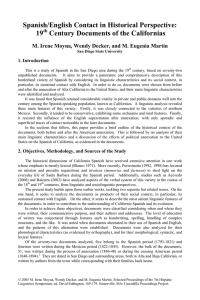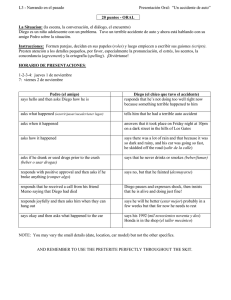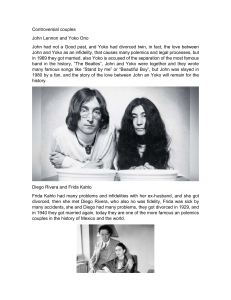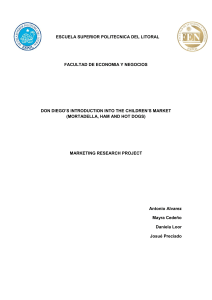WORKSHOP: “EUROPE´S UNTAPPED CAPITAL MARKET
Anuncio
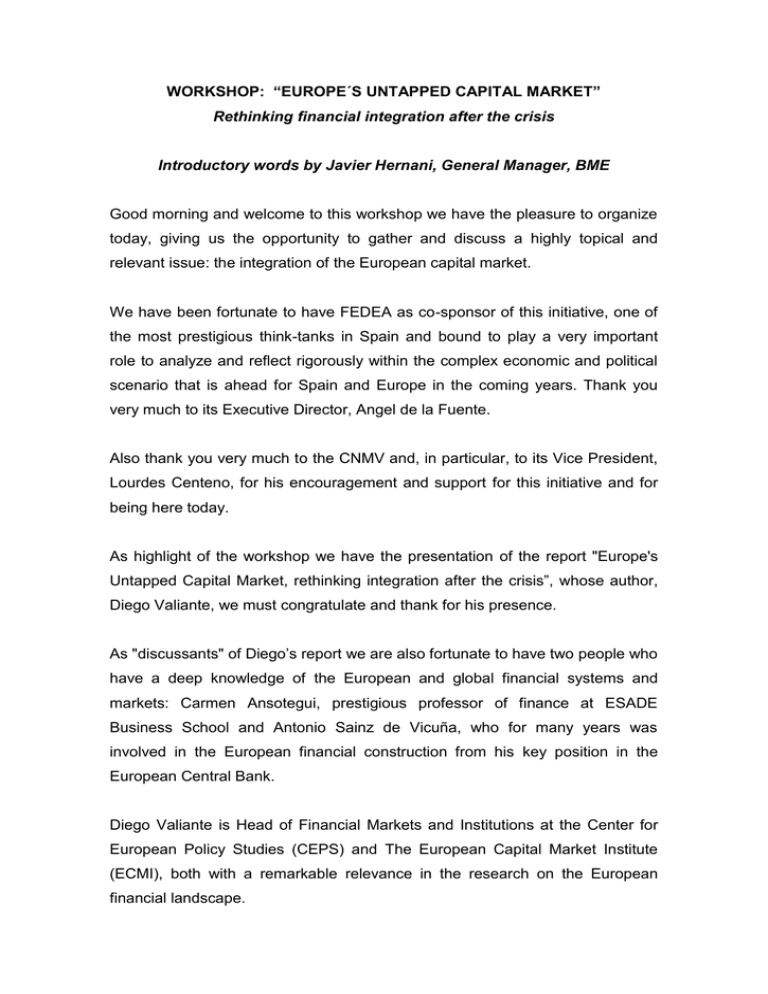
WORKSHOP: “EUROPE´S UNTAPPED CAPITAL MARKET” Rethinking financial integration after the crisis Introductory words by Javier Hernani, General Manager, BME Good morning and welcome to this workshop we have the pleasure to organize today, giving us the opportunity to gather and discuss a highly topical and relevant issue: the integration of the European capital market. We have been fortunate to have FEDEA as co-sponsor of this initiative, one of the most prestigious think-tanks in Spain and bound to play a very important role to analyze and reflect rigorously within the complex economic and political scenario that is ahead for Spain and Europe in the coming years. Thank you very much to its Executive Director, Angel de la Fuente. Also thank you very much to the CNMV and, in particular, to its Vice President, Lourdes Centeno, for his encouragement and support for this initiative and for being here today. As highlight of the workshop we have the presentation of the report "Europe's Untapped Capital Market, rethinking integration after the crisis”, whose author, Diego Valiante, we must congratulate and thank for his presence. As "discussants" of Diego’s report we are also fortunate to have two people who have a deep knowledge of the European and global financial systems and markets: Carmen Ansotegui, prestigious professor of finance at ESADE Business School and Antonio Sainz de Vicuña, who for many years was involved in the European financial construction from his key position in the European Central Bank. Diego Valiante is Head of Financial Markets and Institutions at the Center for European Policy Studies (CEPS) and The European Capital Market Institute (ECMI), both with a remarkable relevance in the research on the European financial landscape. In a document published last year they stated that “the call for a Capital Markets Union has been a useful device to raise awareness about the need for more integration in Europe’s capital markets”. They also recognized that a capital market is easy to define but harder to implement. Compared to bank-based finance, it is much more difficult to put in place. The structure is highly complex and would require years before it becomes fully operational. The different layers that are identified in the securities markets (issuers, investors, infrastructures, intermediaries, government institutions, self- regulatory organisations and laws) are required to work efficiently. Today, people from all these participants in the capital markets are in this room and this is very important. BME, as a market operator itself, is a relevant player in the European capital market. And it is for this reason that we want to contribute with this session to rethinking and discussing those issues that are helping to attain the objective of more and better integration. If there is something that has been revealed as a consequence of the economic and financial crisis, it is precisely the importance of the financing structure of the economy, which has highlighted the role of capital markets. In this general attempt to rethink the role of all agents involved in European capital markets, we often miss concrete measures which address possible and feasible objectives. Diego Valiante´s report offers a methodology to identify and prioritise barriers to the integration of capital markets and provides a set of policy recommendations to improve what he consider its key components: price discovery, execution and enforcement. Up to the present moment, the integration of the European capital markets has not been fully reached but great advances have been attained, especially when working in such a complex environment. Markets such as the Spanish Exchange have made an important effort in adapting to this new landscape, an effort that is resulting in rising trading volumes and more participation of capital and international actors in our systems. The Spanish stock market has for years ranked systematically among the 10 major developed markets in the world, greatly contributing to the growth and internationalisation of the Spanish economy and corporate sector. Since it joined the euro, the Spanish stock market has grown significantly, gradually increasing the levels and channels of financing available to the system while at the same time increasing more than 6-fold its transaction potential in terms of the number of trades and multiplying by more than 3 times the effective trading volume. At the same time the Spanish stock market has been modernised and brought into line with the regulations required in terms of the market model, transparency, investor protection and equal access for all participants in an environment increasingly open to external competition between stock exchanges, systems and trading platforms. The clearest acknowledgement of the positive contribution of the Spanish stock market to the process of integration of the European economy, finance and markets lies in the figures gauging the participation of non-residents in the businesses conducted by companies and their equity capital. In just a few years, the weight of non-residents in the volumes traded has gone from representing 60% to 85% and they own 43% of all the Spanish listed shares (10 points higher than a decade ago). I believe the data for the Spanish stock market can be taken as an example of how in a fragmented and complex ecosystem, there are agents that contribute positively to the integration of others and thus benefit the growth of the entire group. Certainly, as Diego rightly suggested, it is important to continue identifying and breaking down barriers to the integration of the capital markets. To this end the financial system needs to get rid of those “fragments” or nonefficient elements or which prevent the existence of a level playing field. Based on these premises I am sure the traditional markets -such as the Spanish stock exchange - which provide a positive combination of experience and knowledge, and which have the capacity to adapt quickly to new scenarios and to recommend and implement useful solutions for the public and the institutions - must and will have greater presence and value in the path of the European financial integration, which is still many years away from having its own entity and competitive identity. I hope we all end this session with an improved perspective of what the main challenges ahead are, how to put them into practice and with a sense of collaboration among all the agents involved in the integration of European capital markets. For sure, by sharing expertise and different views we will be able to build a better long term project. Thank you for your attention.



